Exam Details
Exam Code
:1Z0-144Exam Name
:Oracle Database 11g: Program with PL/SQLCertification
:Oracle CertificationsVendor
:OracleTotal Questions
:106 Q&AsLast Updated
:Mar 26, 2025
Oracle Oracle Certifications 1Z0-144 Questions & Answers
-
Question 81:
View the Exhibit and examine the structure of the departments table in SCOTT's schema.

Examine the following block of code:
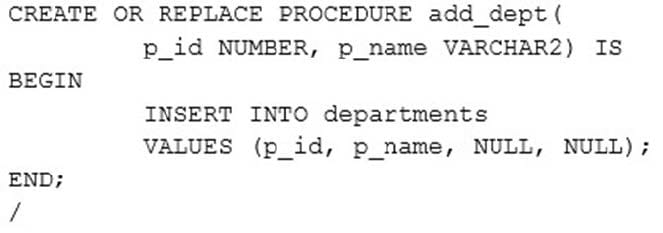
The above procedure is created by user SCOTT. Another user JONES needs to use the procedure.
Which two statements are true in the above scenario? (Choose two.)
A. JONES executes the procedure with definer's rights.
B. JONES executes the procedure with invoker's rights.
C. SCOTT should grant only the execute privilege for the procedure to JONES.
D. SCOTT should grant both the execute privilege for the procedure and insert privilege for the table to JONES.
-
Question 82:
Which two statements are true about statement-level and row-level triggers? (Choose two.)
A. A row trigger fires once even if no rows are affected.
B. A statement trigger fires once even if no rows are affected.
C. Row triggers are useful if the trigger action depends on the data of rows that are affected or on data that is provided by the triggering event itself.
D. Statement triggers are useful if the trigger action depends on the data of rows that are affected or on data that is provided by the triggering event itself.
-
Question 83:
Identify two features of obfuscation. (Choose two.)
A. The Import and Export utilities accept wrapped files.
B. SQL' Plus cannot process the obfuscated source files.
C. Only the wrap utility can obfuscate multiple programs at a time.
D. Both the DBMS_DDL package and the Wrap utility can obfuscate multiple programs at a time.
E. The source code is visible only through the DBA_SOURCE view and not through the USER_SOURCE or ALL_SOURCE View
-
Question 84:
Which two statements are true about the continue statement? (Choose two.)
A. The PL/SQL block execution terminates immediately.
B. The CONTINUE statement cannot appear outside a loop.
C. The loop completes immediately and control passes to the statement after end loop.
D. The statements after the continue statement in the iteration are executed before terminating the LOOP.
E. The current iteration of the loop completes immediately and control passes to the next iteration of the loop.
-
Question 85:
View the Exhibit and examine the code and its outcome on execution:
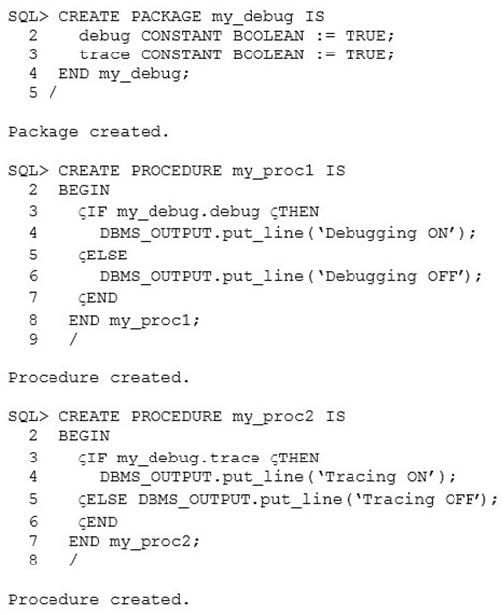
What would be the effect on the two procedures if the value of debug is set to FALSE? (Choose two.)
A. MY_PROC2 is not recompiled.
B. MY_PROC1 is recompiled but remains unchanged.
C. MY_PROC2 is recompiled but remains unchanged.
D. MY_PROC1 is recompiled without the debugging code.
-
Question 86:
/temp/my_files is an existing folder in the server, facultylist.txt is an existing text file in this folder.
Examine the following commands that are executed by the DBA:
SQL>CREATE DIRECTION my_dir AS `/temp/my_files': SQL>GRANT READ ON DIRECTORY my_dir To public:
View the Exhibit and examine the procedure created by user SCOTT to read the list of faculty names from the text file.
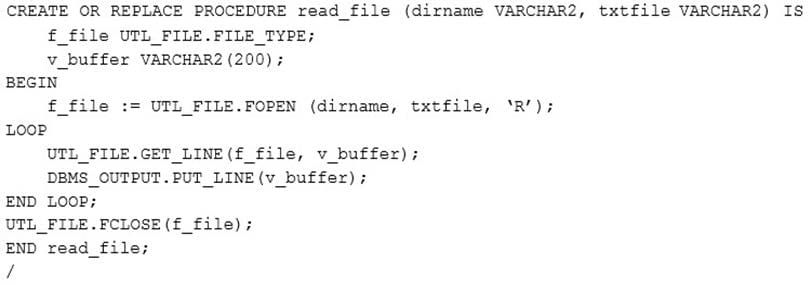
SCOTT executes the procedure as follows:
SQL>SET SERVEROUTPUT ON
SQL>EXEC read_file (`MY_DIR', FACULTYLIST.TXT')
What is the outcome?
A. It goes into an infinite loop.
B. It executes successfully and displays only the list of faculty names.
C. It does not execute and displays an error message because the end-of-file condition is not taken care of.
D. It executes successfully and displays the list of faculty names followed by a "no data found" error message.
-
Question 87:
View the Exhibit to examine the PL/SQL block.
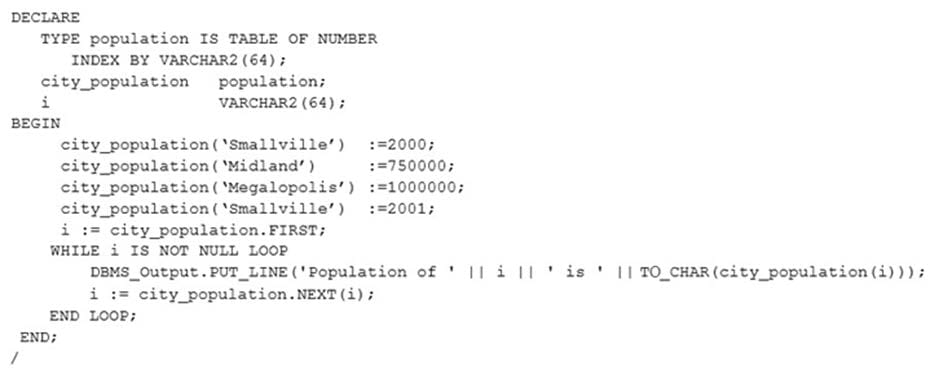
Which two statements are true about the execution of the PL/SQL block? (Choose two.)
A. It executes successfully and gives the desired output.
B. It does not execute because the definition of type POPULATION is indexed by VARCHAR2.
C. It executes, and the string keys of an associative array are not stored in creation order, but in sorted order.
D. It does not execute because the value that is once assigned to the element of the associative array cannot be changed.
-
Question 88:
User SCOTT has been granted CREATE ANY TRIGGER and ALTER ANY TABLE by the DBA. HR is an
existing schema in the database.
SCOTT creates the following trigger:
CREATE OR REPLACE TRIGGER drop_trigger
BEFORE DROP ON hr.SCHEMA
BEGIN
RAISE_APPLICATION_ERROR (-20000, `Cannot drop object');
END;
SCOTT does not grant the EXECUTE privilege on this trigger to any other users.
For which user(s) would this trigger fire by default when they drop an object in the HR schema?
A. Only HR
B. SCOTT and HR
C. Only SCOTT
D. SCOTT, HR, and SYS
-
Question 89:
Which two statements are correct about the usage of parameters in functions? (Choose two.)
A. Functions can have only in mode parameters.
B. Functions called in SQL statements cannot have out or in out mode parameters.
C. Functions having in, out, or in out parameters can be called only in named PL/SQL subprograms
D. Functions having in, out, or in out parameters can be called in PL/SQL procedures and anonymous blocks.
-
Question 90:
View the Exhibit and examine the structure of the employees table.
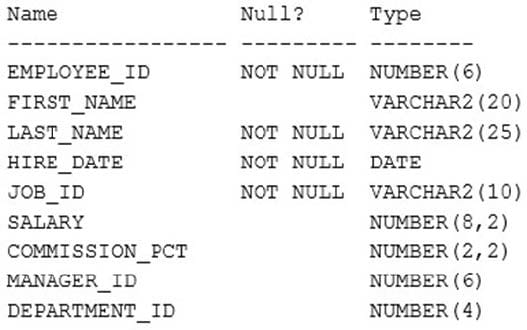
Examine the following block of code:
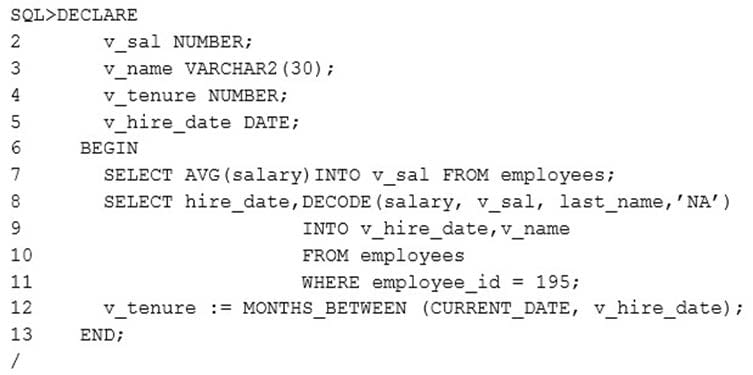
What is the outcome when the above code is executed?
A. It executes successfully.
B. It gives an error because decode cannot be used in a PL/SQL block.
C. It gives an error because the AVG function cannot be used in a PL/SQL block
D. It gives an error because the MONTHS_BETWEEN function cannot be used in a PL/SQL block.
E. It gives an error because both the AVG and decode functions cannot be used in a PL/SQL block.
Related Exams:
1Z0-020
Oracle8i: New Features for Administrators1Z0-023
Architecture and Administration1Z0-024
Performance Tuning1Z0-025
Backup and Recovery1Z0-026
Network Administration1Z0-034
Upgrade Oracle9i/10g OCA to Oracle Database OCP1Z0-036
Managing Oracle9i on Linux1Z0-041
Oracle Database 10g: DBA Assessment1Z0-052
Oracle Database 11g: Administration Workshop I1Z0-053
Oracle Database 11g: Administration II
Tips on How to Prepare for the Exams
Nowadays, the certification exams become more and more important and required by more and more enterprises when applying for a job. But how to prepare for the exam effectively? How to prepare for the exam in a short time with less efforts? How to get a ideal result and how to find the most reliable resources? Here on Vcedump.com, you will find all the answers. Vcedump.com provide not only Oracle exam questions, answers and explanations but also complete assistance on your exam preparation and certification application. If you are confused on your 1Z0-144 exam preparations and Oracle certification application, do not hesitate to visit our Vcedump.com to find your solutions here.